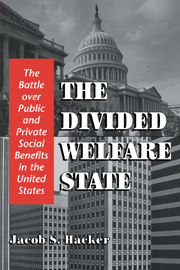Book contents
- Frontmatter
- Contents
- List of Tables
- List of Figures
- Preface
- Part I The American Welfare Regime
- Part II The Politics of Public and Private Pensions
- Introduction
- 2 Connected at Birth: Public and Private Pensions Before 1945
- 3 Sibling Rivalry: Public and Private Pensions After 1945
- Part III The Politics of Public and Private Health Insurance
- Part IV The Formation and Future of the American Welfare Regime
- Appendix
- Notes
- Index
2 - Connected at Birth: Public and Private Pensions Before 1945
Published online by Cambridge University Press: 05 June 2012
- Frontmatter
- Contents
- List of Tables
- List of Figures
- Preface
- Part I The American Welfare Regime
- Part II The Politics of Public and Private Pensions
- Introduction
- 2 Connected at Birth: Public and Private Pensions Before 1945
- 3 Sibling Rivalry: Public and Private Pensions After 1945
- Part III The Politics of Public and Private Health Insurance
- Part IV The Formation and Future of the American Welfare Regime
- Appendix
- Notes
- Index
Summary
The development of public and private pensions prior to the close of World War II can be divided into two periods, punctuated by the Great Depression and the New Deal reforms that followed. Before the passage of the Social Security Act, public retirement pensions such as we now know them did not exist. Public pensions were designed to serve “deserving” groups that were not necessarily aged – veterans, widows, the severely disabled – or to provide occupational benefits to government workers. As for private pension plans, pioneering employers in large industries adopted them as early as 1875, but as late as 1929, plans were still relatively scarce, and even for workers ostensibly covered, their benefits were highly uncertain. Although the old-age insurance program contained in the Social Security Act emulated the best private plans in many respects, its broad and compulsory coverage – compromised, but not abandoned, by Congress – cast in stark relief the weaknesses of the fledgling private pension system. It challenged, too, the unfettered management prerogatives of American business, whose most vocal leaders had argued to the end that employers should not have to shoulder new burdens that would imperil profits or gut the existing network of private plans so identified with the pre–New Deal vision of “welfare capitalism.”
After the passage of old-age insurance, however, private pension plans began to flourish as never before. The reasons for this were multiple, but ironically, much of the impetus came from Social Security itself.
- Type
- Chapter
- Information
- The Divided Welfare StateThe Battle over Public and Private Social Benefits in the United States, pp. 85 - 123Publisher: Cambridge University PressPrint publication year: 2002

